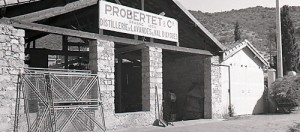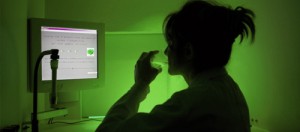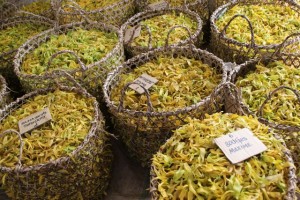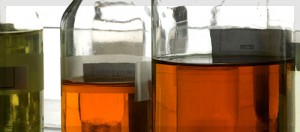This all started in the backroom at the Atelier Cologne store on Elizabeth St. the Friday before last May’s Sniffapalooza Spring Fling. Sylvie Ganter was giving me a preview of the two new fragrances that were just released, Rose Anonyme and Vetiver Fatal. While I was sniffing the latter one for the first time I didn’t detect the normal woody finish to the titular vetiver. Ms. Ganter told me that it was because the perfumer Jerome Epinette of Robertet used a fractionated vetiver instead of the whole absolute extract. Now for most of you there are probably a number of concepts in that last sentence that would contain some interest for you. For me the word that set my heart aflutter and my mind whirling was “fractionated”. You see that is a chemistry term and I thought I understood exactly what that meant and so I promised myself to do some more research. Little did I know about 24 hours later the key to my understanding would be sharing lunch with me.
The next day at the Spring Fling lunch I was seated with a great table of perfume lovers and I started talking to Rhona about my experience the day before. It was at this point Rhona further introduced herself as Rhona Stokols of the Fine Fragrance Sales Group at Robertet. Then she invited me to come visit the lab and see for myself how Robertet creates their ingredients. This was my first time being invited to see a perfume laboratory operation and be able to ask all of the science geeky questions which crowd my overheated mind. Thanks to Rhona we were able to schedule a Monday in early July for me to come visit and learn about fragrant fractions without having to worry about the lowest common denominator.
When I arrived at the offices in the Crown Building in midtown Manhattan Arnaud Adrian gave me an overview of all that Robertet does with sourcing and creating natural ingredients. He couldn’t do it in person because he was in France overseeing the lavender harvest and that turned out to be very apt. Robertet was started in 1850 by Paul Robertet and the sign you see on the building above is the original sign from back then. As you can see they began as a distiller of lavender. As Robertet has grown they have spread to almost every corner of the globe and what really was pleasing to me is their program called “Seed to Scent”. This is Robertet’s promise to be involved with their ingredients from the farming all the way through to being used by a perfumer. M. Adrian showed me this commitment by showing me the schools built and the impact on the farming communities they use in the undeveloped world. It was this part of the presentation that brought home Chandler Burr’s quote from the roundtable at January’s Elements Showcase, “The entire world is in every bottle of perfume.” What I came away with was an appreciation for the effort Robertet puts into making sure these sources are sustainable and they produce a positive impact on the community farming them.
I bombarded M. Adrian with questions throughout his presentation and what should’ve taken an hour took much longer. Especially when we finally got to the subject which started this the Robertet fractionation of natural extracts. Here is a simple, I hope, explanation of fractionation. When you are distilling off an essential oil it boils over a range of temperature, for the purposes of this discussion we will say 100-110 degrees. If someone was to ask for the boiling point of this oil they would tell you it is 105 because that is the way you communicate it but most things are distilled over a range. Now if you want to break down that range that is when you are trying to fractionate it. The technique involves lengthening the path from the pot to the receiver. The longer the length the more separation that occurs during the process and you can collect fractions of the oil as it comes off. Instead of collecting from 100-110 degrees you now collect whatever distills off from 100-102, then you collect what distills off from 102-104. If you did this every two degrees you would end up with five fractions. In the end you would expect these fractions to all basically smell like the original source but as I found with my experience with Vetiver Fatal there is a great deal of difference to be found. Senior Perfumer at Robertet Olivia Jan would be my tour guide and teacher as she showed me the difference these fractions could make.
Mme Jan gave my nose a tour of all of the different ways Robertet uses to create new tools for the master perfumer’s palette. I was fixated on my fractions but Mme Jan needed to bring me up to the level necessary for my nose to appreciate them. As we worked our way through oils and essences I found there was something else which caught my attention. There is a process where they mix two extracts together and do a co-distillation of those extracts which produces an effect of creating a mixture of both which distills at a lower temperature than either component, this is called an azeotrope and it is usually the first thing off the distillation head. What Mme Jan showed me was the co-distillation of pine needles and cedar, Robertet calls this Bois des Landes. When I mixed a drop of these two oils together I got a nose-searing blast of camphor and pencil shavings it was awful. Now throw them in a pot and heat them up together and collect the azeotrope you get Bois des Landes. Bois des Landes has the smell of pine needles and it also has the balsamic nature of both woods but what this also creates is a subtle blackcurrant quality that is amazing to behold. Somehow by co-distilling a new facet is brought out of these ingredients. The idea that blackcurrant can come out of mixing pine and cedar, fascinating.
Now Mme Jan was ready to teach me my fractions. We started with Petitgrain oil and it was what I expected from petitgrain; a bit green a bit citrus nothing surprising. Then I was passed Bigaradier Coeur and what a difference this fraction of petitgrain had it was greener and more floral more like orange flower than the bitter orange quality so familiar with petitgrain. Bigaradier Coeur was soft and green and something entirely different.
Next up was Cedar, again I had smelled the Cedar when we smelled Bois des Landes so when I was handed Cedar 114 I was not ready for the experience. If I say cedarwood to almost any perfumista the first association would be either clean or pencil shavings. Cedar 114 smells smoky, leathery, almost like sun baked skin. I immediately picked up the mouillette with the source Cedar oil on it searching for these qualities, keenly tuned into looking for them and couldn’t find them. This seems like magic where the magician turns a rabbit into a lion. Cedar 114 doesn’t seem like it possibly could have come from the Cedar oil I smelled.
My last lesson was in ylang-ylang and this was one that I had heard about because there was an ylang fraction in Rose Anonyme. Robertet has taken ylang extract and split it into six fractions. The fraction I was given to try was called Lisylang Heart. As I held this to my nose I now had no idea what I was going to smell. This time the magic of fractionation has created a spicy lily fraction pure and clean in its quality; no indoles passed the distillation head in this fraction. The surprise is this is no shrinking violet of a lily this contains power and force to it and again no matter how much I sniff the parent Ylang III I can’t find it in the un-fractionated original.
I asked Mme Jan how this affects her ability to realize the briefs she is given to bring to life and she told me that it increases the chances of her being able to realize a specific effect. When she knows she would like the freshness of ylang without the deeper heavier notes she could reach for Lisylang Heart and that might be exactly what she needs.
My lesson was sadly over but the team at Robertet gave me vials of all of the oils I had tried and I have spent a lot of time with them since my visit. My first lesson is when companies like Robertet continue to innovate and create with natural materials I believe the future of perfumery is in great hands.
My thanks to Rhona Stokols, Jennifer Powderly, Olivia Jan and Adrian Arnaud for taking the time out of their busy schedule to talk with me and teach me my fractions all over again.
–Mark Behnke, Managing Editor
Editors' Notes: For those in the NYC area Robertet is doing two workshops focusing on their new rose petal distallation at the Elements Showcase at 10 AM on Monday and Tuesday August 20 and 21, 2012. Adrian Arnaud, Olivia Jan and Jerome Epinette will be working with Mandy Aftel of Aftelier on Monday’s workshop and with Charna Ethier of Providence Perfume Co. and Anne McClain of MCMC Fragrances on Tuesday’s workshop. Both interactive seminars are moderated by Robertet's Jennifer Powderly, Director of Marketing. Come see some of our most talented indie perfumers co-create with Robertet’s team. More information at the Elements Showcase link here.
For those who want more information on Robertet’s Seed to Scent program check out their blog In The R at this link.








